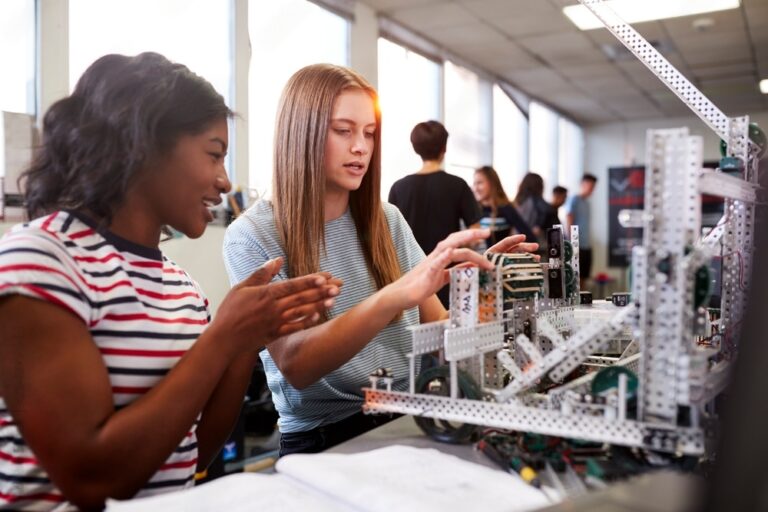Women in STEM

Engineering has traditionally been a male-dominated field, but efforts to diversify and include women have gained momentum in recent years. Diversity fuels innovation. As we embrace the transformative power of technology, it’s imperative to recognize that progress thrives on the shoulders of inclusivity. Let’s explore the significance of diversity and inclusion in engineering, particularly focusing on initiatives supporting women in STEM fields and creating more inclusive workplaces.
Why Diversity and Inclusion Matter in Engineering
Diversity and inclusion are crucial for fostering innovation, creativity, and problem-solving in engineering. When teams comprise individuals with diverse backgrounds, perspectives, and experiences, they can approach challenges from different angles and develop more robust solutions. Inclusive environments also promote collaboration and communication, leading to higher levels of productivity and job satisfaction among employees.
Moreover, diversity in engineering reflects the diversity of the world we live in. By including people from different genders, races, ethnicities, and cultures, we can ensure that engineering solutions are relevant, accessible, and equitable for all members of society. This not only enhances the effectiveness of engineering projects but also contributes to social justice and equality.
Supporting Women in STEM: Programs and Initiatives
Numerous programs and initiatives have emerged to support women in STEM and address the gender gap in engineering. These initiatives operate at various levels, from grassroots organizations to multinational corporations, and encompass a wide range of activities aimed at empowering women in their engineering careers.
Mentorship programs are a cornerstone of efforts to support women in STEM. These programs pair aspiring female engineers with experienced professionals who provide guidance, advice, and support throughout their careers. Mentorship not only helps women navigate the challenges of the male-dominated engineering industry but also enables them to build networks, access opportunities, and develop essential skills for career advancement.
STEM education outreach programs targeted at young girls are also instrumental in encouraging women to pursue careers in engineering. By exposing girls to STEM disciplines early on and breaking down gender stereotypes, these programs aim to inspire and empower the next generation of female engineers. Examples include workshops, summer camps, and mentorship programs designed to spark interest in STEM fields and cultivate confidence in young girls’ abilities.
Furthermore, companies and organizations are implementing diversity and inclusion initiatives within their workplaces to create a supportive environment for women in STEM. These initiatives may include diversity training, flexible work arrangements, family-friendly policies, and affinity groups or employee resource groups (ERGs) for women in engineering. By fostering a culture of inclusion and equity, these initiatives not only attract and retain female talent but also enhance overall workplace satisfaction and productivity.
Examples of Successful Initiatives
One notable example of a successful initiative is the Women in Engineering (WIE) program established by the Institute of Electrical and Electronics Engineers (IEEE). The WIE program offers networking opportunities, professional development resources, and advocacy initiatives to support women in all branches of engineering. Through conferences, workshops, and online communities, WIE provides a platform for women to connect, collaborate, and advance their careers in engineering.
Another example is the Women@NASA initiative, which aims to promote gender diversity and inclusion within the National Aeronautics and Space Administration (NASA). Women@NASA offers mentorship programs, leadership development opportunities, and recognition awards to support women in various STEM fields, including engineering, aerospace, and computer science. By championing women’s contributions and accomplishments, Women@NASA seeks to inspire future generations of female engineers and scientists.
In the corporate sector, companies like Microsoft have implemented comprehensive diversity and inclusion initiatives to support women in STEM. Microsoft’s Diversity and Inclusion program includes targeted recruitment efforts, leadership development programs, and employee resource groups for women in technical roles. Through initiatives like the Microsoft Women in Engineering (WinE) community, the company fosters a culture of inclusion and belonging, where women are empowered to thrive and succeed in engineering careers.
Challenges and Opportunities Ahead
Despite the progress made in supporting women in STEM, significant challenges persist, including unconscious bias, workplace discrimination, and the lack of representation in leadership positions. Addressing these challenges requires a concerted effort from all stakeholders, including government agencies, educational institutions, corporations, and professional organizations.
Moreover, as technology continues to advance rapidly, new opportunities and challenges emerge for women in engineering. Fields such as artificial intelligence, cybersecurity, and renewable energy present exciting avenues for innovation and growth, but they also require diverse perspectives and interdisciplinary collaboration to address complex societal issues.
Conclusion
Engineering empowerment encompasses the promotion of diversity, inclusion, and equity in STEM fields, with a particular focus on supporting women in engineering careers. By fostering diverse and inclusive workplaces, we not only create opportunities for individual success but also drive innovation, progress, and societal impact. Through initiatives and programs aimed at empowering women in STEM, we can cultivate a more inclusive engineering ecosystem where all individuals have the opportunity to thrive and contribute to building a better future.
